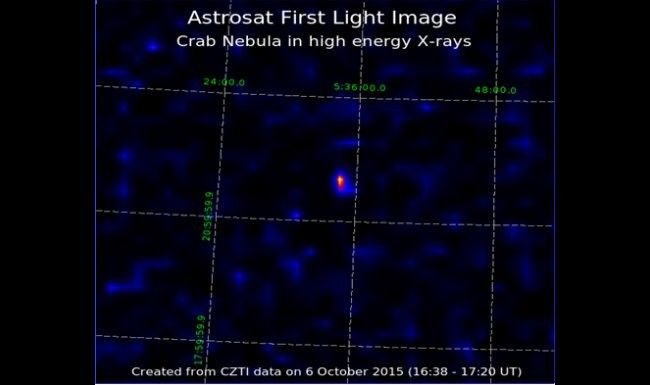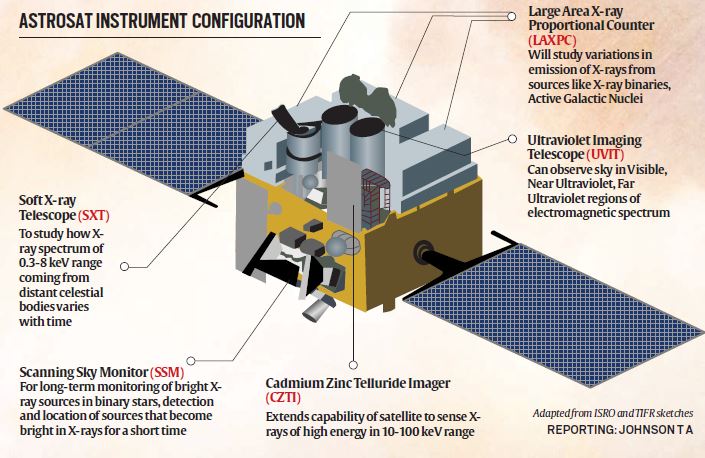Indian Astrosat Space Observatory Discovers New Feature Of Black Hole - Science/Technology - Nairaland
Nairaland Forum / Science/Technology / Indian Astrosat Space Observatory Discovers New Feature Of Black Hole (1411 Views)
Universe As Seen From Indian Space Observatory / Scientist Discovers New Gravitational Waves From Black Hole Collision / What Do You Know About A Black Hole? (2) (3) (4)
| Indian Astrosat Space Observatory Discovers New Feature Of Black Hole by Nobody: 7:08am On Sep 03, 2016 |
On 12th October 2015, the Indian Space Research Organisation (ISRO) tweeted a mesmerising image of Crab Nebula which is one of the brightest hard X-ray sources in the sky. The tweet marked a new scientific achievement;  India is now just the fourth nation to have this sort of lookout in orbit. Space-based observatories are similar to a major telescope fitted on a satellite rotating around the earth in a settled orbit, and making observations in the unfathomable universe. ASTROSAT, which India launched on 28th September is gazing the far off stars. According to ISRO, now “Astrosat would be looking at some of the black hole sources/candidates like GRS 1915+105, Cygnus X-1, Cygnus X-3 during the month of November.”  shot of crab nebula It is a well-known fact that earth is surrounded by a layer of atmosphere and this layer can possibly square X-Ray, Infrared and Ultraviolet beams. It can likewise distort/twist Microwaves and Visible light which has an immediate effect on the picture quality of ground-based telescopes. In spite of the fact that some of these issues can be rectified by setting observatories on higher elevations, furthermore utilising technological advances like adaptive optics, but they still have their limits. Additionally even space-based radio and visible light telescopes are complementary in nature to their earth based counterparts. As a space-based telescope won’t be affected by climatic twists furthermore by simulated or artificial lights, it will give us sharp pictures of space and remote cosmic systems. ASTROSAT’s primary science objectives are: 1.Understand high-energy processes in binary systems 2.Search for black hole sources in the galaxy 3.Measure magnetic fields of neutron stars 4.Study high-energy processes in extra-galactic systems 5.Detect new transient X-ray sources 6.Perform limited high angular-resolution deep field survey in UV  The repeated mentions of high-energy are synonymous with the parts of the electromagnetic spectrum ASTROSAT will study – X-ray and ultraviolet emissions have higher frequencies and thus higher energies. In fact, its LAXPC (Large Area X-ray Proportional Counter) instrument will be superior to the NASA NuSTAR X-ray telescope: both will be logging X-ray emissions corresponding to the 6-79 keV* energy range but LAXPC’s collecting area will be almost 10x the collecting area of NuSTAR’s. Similarly, ASTROSAT’s UV instrument, the Ultraviolet Imaging Telescope, studies wavelengths of radiation from 130 nm to 320 nm, like the Cosmic Origins Spectrograph on board the Hubble spans 115-320 nm. COS has a better angular and spectral resolution but UVIT, as well as the Scanning Sky Monitor that looks for transient X-ray sources, tops with a higher field of view. The UVIT and LAXPC double up as visible-wavelength detectors as well. In contrast, the Hubble makes observations in the infrared, visible and UV parts of the spectrum. Its defining feature is a 2.4-m wide hyperbolic mirror that serves to ‘collect’ photons from a wide field of view onto a secondary hyperbolic mirror, which in turn focuses into the various instruments (the Ritchey-Chrétien design). ASTROSAT also has a primary collecting mirror; it is 30 cm wide. [img]http://www.isro.gov.in/sites/default/files/galleries/%E0%A4%97%E0%A5%88%E0%A4%B2%E0%A4%B0%E0%A5%80/15.jpg[/img] Astrosat, the Indian space telescope, has found a new, interesting feature about an enigmatic black hole that could help scientists unravel some of the mysteries about the cosmic monster. Located at a distance of 40,000 light years (one light year is 9 trillion km) in the constellation of Aquila, the black hole is part of a two-star system, both of which are extremely hot, radiating several types of high-energy rays. Using the Astrosat data, Indian astronomers identified some peculiarity in the high-energy or hard X-ray release pattern that could eventually lead to a better understanding of the black hole — the dying phase of a heavyweight star, which is too heavy even for light to escape, making them black. The black hole is part of a binary star system known as GRS 1915+105 which consists of a regular star and a black hole. The regular star has a temperature of about 6000 degrees Kelvin. The black hole strips matter from the star to form an accretion disc whose temperature is about 100 million Kelvin. “We made the discovery with only nine hours of Astrosat observation. The telescope will be in space for the next 5-10 years and can generate more valuable scientific information,” Ranjeev Misra, an astrophysicist at the Inter-University Centre for Astronomy and Astrophysics (IUCAA), Pune, who is part of the team that made the discovery told DH “The system was 50,000 times more luminous than our sun. Yet just like a flickering candle, the strength of the X-ray emission changes in one-fifth of a millisecond. This has never been seen before,” Misra said. The two-star system was discovered way back in 1992 and observed by many scientists through different telescopic windows so far. The discovery may help understand new aspects of Albert Einstein’s general theory of relativity and probe the space-time around the black hole,” he said. The findings are accepted for publication in Astrophysical Journal. [img]http://2.bp..com/-CAHJ2HAGCfg/ViutZQxm47I/AAAAAAAAcBk/j789VdpIDqE/s1600/Astrosat_New_1.jpg[/img] |
| Re: Indian Astrosat Space Observatory Discovers New Feature Of Black Hole by Nobody: 7:45am On Sep 03, 2016 |
[img]http://1.bp..com/-jMPH8G_MC_c/VqTJ6fhm6WI/AAAAAAAAkwk/XNMoNsQRWfc/s1600/ISRO_Human_Space.jpg[/img] ISRO's Conception of the Human Rated Orbital Vehicle. design and testing of OV is in progress UAE, Isro ink deal for launching first Arab Mars mission  ISRO signed a deal on feb 11, 2016 with its counterpart in the United Arab Emirates to launch Arab world’s first ever mission to Mars. The MoU between ISRO and UAE space agency is among several that would be signed during the visit of Emirates’ de-facto ruler and crown prince of Abu Dhabi, Sheikh Mohammed bin Zayed Al Nahyan to New Delhi. The countries will also ink an agreement to set up UAE-India Infrastructure Investment Fund aiming to boost UAE’s investment in India’s infrastructure sector up to $75 billion. The fund would focus on railways, ports, roads, airports, industrial corridors and parks, officials told Deccan Herald Wednesday. Sheikh Mohammed, also the Deputy Supreme Commander of UAE Armed Forces, arrived in New Delhi on Wednesday. He will hold a private meeting with Prime Minister Narendra Modi Thursday morning and the two leaders will also lead their country’s respective delegations in the evening. The Arab leader will also meet President Pranab Mukherjee. In July 2014, The UAE announced its decision to launch Arab world’s first ever satellite to Mars in July 2020. |
| Re: Indian Astrosat Space Observatory Discovers New Feature Of Black Hole by Nobody: 7:54am On Sep 03, 2016 |
Indian Chandrayaan 2 mission progressing well. it is mission to send a orbiter, lander and rover to moon within 2 years.
|
| Re: Indian Astrosat Space Observatory Discovers New Feature Of Black Hole by Nobody: 5:58pm On Sep 03, 2016 |
This thread describes the agency more than the phenomenon itself |
(1) (Reply)
Clean Infinix S4 For Sale 35K / 10 Facts About Electricity / How To Turn Your Windows PC Into A Wi-fi Hotspot - W3howto.com Guide
(Go Up)
| Sections: politics (1) business autos (1) jobs (1) career education (1) romance computers phones travel sports fashion health religion celebs tv-movies music-radio literature webmasters programming techmarket Links: (1) (2) (3) (4) (5) (6) (7) (8) (9) (10) Nairaland - Copyright © 2005 - 2024 Oluwaseun Osewa. All rights reserved. See How To Advertise. 40 |